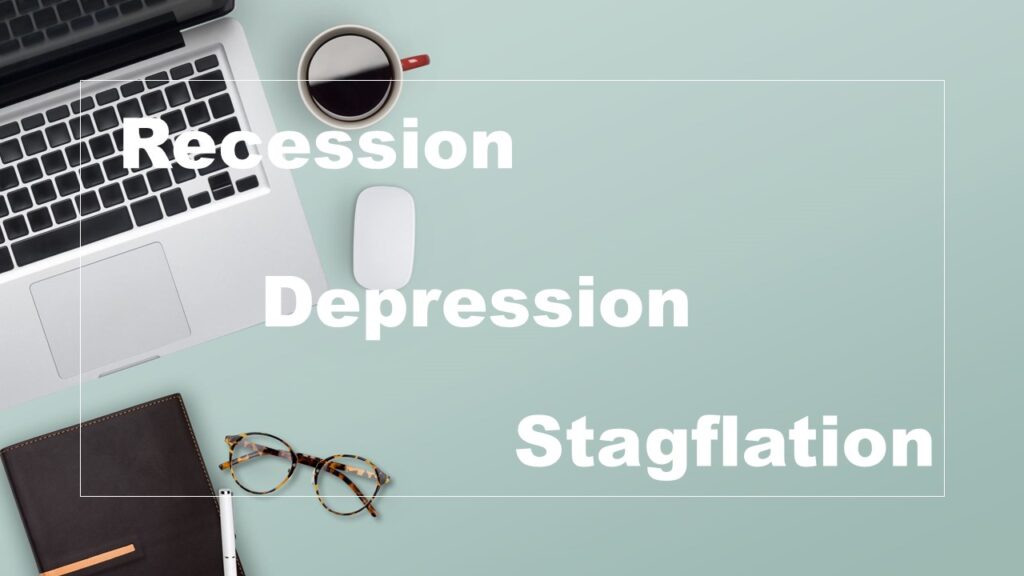
If you listen to the news recently you like very likely hear these 3 words a lot: “Recession”, “Depression”, and “Stagflation”. What do they exactly mean?
Recession
A recession is defined that an economy is seeing negative growth in GDP (gross domestic product) for two consecutive quarters. A recession might be caused by tight monetary and social policies aimed at controlling inflation (like what we are experiencing right now). It can also be caused by other reasons such as companies and individuals cutting back consumption and investment after a period of over-leveraging.
Coming out from a recession, the economy might recover in V-shape (strong recovery after a sharp decline), W-shape (marginal recovery followed by decline followed by eventual recovery), or L-shape (economy goes down and stagnates there). Are we in a recession now? If yes what does the recovery look like?
Depression
A depression is a severe and prolonged downturn in economic activities, typically lasting longer than a year or having a decline in GDP of more than 10%. Depression is less frequent than a recession and usually accompanied by higher unemployment and low inflation. One of the famous depressions is the Great Depression in the US from 1929 to 1933 where GDP declined 26.7% from its peak and took years to fully recover.
Stagflation
Stagflation is to describe a state of the economy where inflation is high during a period of slow economic growth. Many reasons could cause inflation (for example prolonged relaxed monetary policies, supply chain issues, and wars). The high prices lead to a slowing in demand, which leads to a further economic slowdown. Our current state of the economy feels very much like stagflation.
During stagflation, an increase in interest rate is usually used to combat high inflation, however, high rates will make the economy hard to recover. If the interest rate is decreased, it might fuel inflation. Hence the government and central banks in the world are having a difficult time now combating inflation, and fuel economy, and take the economy out of stagflation, and preventing a potential recession (or even depression)!
当你最近看新闻的时候,你会常常听到这三个词:“Recession 经济衰退”,“Depression 经济萧条”,“Stagflation 经济滞胀”。它们究竟是什么意思?
Recession (经济衰退)的定义是一个经济体的 GDP(国内生产总值)连续两个季度出现负增长。 经济衰退可能是由旨在控制通货膨胀的紧缩货币政策和社会政策引起的(就像我们现在正在经历的那样),也可能是其他原因造成的,比如公司和个人在过度增长一段时间后减少消费和投资。
从衰退中走出来,经济可能会以 V 形(急剧下降后强劲复苏)或 W 形(复苏,然后下降,然后最终复苏)或 L 形(经济行为下降并停滞在那里)。 我们现在处于经济衰退之中吗? 如果是,经济会怎么复苏?
Depression(经济萧条)是经济活动的严重消退和长期低迷,通常持续时间超过一年或 GDP 下降超过 10%。萧条的发生频率远低于衰退,通常伴随着高失业率和低通胀。著名的萧条之一是美国从 1929 年到 1933 年的大萧条,当时 GDP 从峰值下降了26.7%,并且需要数年时间才能完全恢复。
Stagflation(经济滞胀)是描述在经济增长缓慢期间通货膨胀率很高的经济状态。许多原因都可能导致通货膨胀(例如长期宽松的货币政策、供应链问题、战争)。高价格导致需求放缓,进而导致经济进一步放缓。 我们目前的经济状况很像是经济滞胀。
在经济滞胀期间,加息通常被用来对抗高通胀,但高利息会让经济很难复苏。如果利率下降,有可能会加剧通货膨胀。因此,世界各国政府和中央银行现在正面临两难来对抗通货膨胀、复苏经济、摆脱滞胀,并防止潜在的衰退(甚至萧条)!
#recession #depression #stagflation
For other topics on financial intelligence, you can find it here https://nickandmoney.com/category/fi/
Follow me on Twitter: https://twitter.com/nickandmoney
nick and money – improve your finances and wellbeing